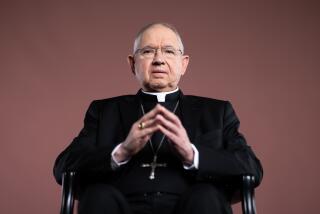Steinbock Named Bishop of Santa Rosa : Auxiliary in Diocese of Orange to Assume New Office March 31
- Share via
John T. Steinbock, the first and only auxiliary bishop of the Diocese of Orange, has been appointed head of the Diocese of Santa Rosa in Northern California, the Vatican announced Tuesday.
In a statement, Steinbock expressed gratitude to Pope John Paul II “for the confidence and trust he places in me with this appointment.” He said he “will miss very much the many people in the Diocese of Orange whom I have come to know and love.”
Steinbock, who is fluent in Spanish, came to Orange County from St. Vibiana’s Cathedral in downtown Los Angeles, where he ministered to many people on Skid Row. Church observers attributed his appointment at the time to a need to assist the then-ailing Bishop William R. Johnson, the first bishop of Orange, and to address the needs of the diocese’s growing number of Latino parishioners.
Johnson died last July, and Steinbock was named diocesan administrator in his place. Earlier this month, however, Bishop Norman F. McFarland of the Reno-Las Vegas Diocese was named to succeed Johnson.
‘A Natural Choice’
McFarland, who is scheduled to be installed Feb. 24, said in a telephone interview from Reno that he wished that Steinbock could stay around longer to help “guide me” in Orange County. McFarland added that Steinbock, who is scheduled to be installed in his new post March 31, is nonetheless “a natural choice” for the new post.
Steinbock’s appointment to Santa Rosa was long rumored by clergy in the Orange and Los Angeles dioceses.
In a telephone interview, Steinbock acknowledged the rumors but said “it’s always a surprise until you know it’s official.”
Though respected, Steinbock was considered by some church members to be too young at 49 to head a diocese the size of Orange, with more than 500,000 Catholics. (Los Angeles Archbishop Roger M. Mahony was 49 years old when he was installed in 1985.)
Steinbock’s appointment to Santa Rosa was “logical,” according to Father Thomas J. Reese, a Georgetown University authority on the selection of bishops. “He’s clearly qualified to be a diocesan bishop. He’s someone with obvious talents.”
The largely rural Santa Rosa diocese, with about 125,000 Catholics, has been awaiting appointment of a new bishop for nearly a year, since Bishop Mark J. Hurley, 67, resigned to take a Vatican post. Hurley, who underwent heart surgery in September, has continued to run the diocese while awaiting the appointment of a successor.
Like the Diocese of Orange, which was split off from Los Angeles a decade ago, the Diocese of Santa Rosa, which stretches across six counties from the Bay Area to the Oregon border, was created from the Archdiocese of San Francisco in 1962.
Hope Post is Re-Filled
Both Steinbock and McFarland said they hope that the Vatican will appoint a new auxiliary bishop for Orange County. Other dioceses in the West with fewer Catholics have one or more auxiliary bishops, each pointed out.
“Should Orange have one?” McFarland asked. “You bet! . . . I surely think we deserve it,” he said, because of the Catholic population and the amount of work to be done.
McFarland does not speak Spanish, and, in contrast with the late Bishop Johnson, the bishop-elect is considered a conservative on such non-doctrinal issues as sanctuary for illegal aliens, the death penalty and nuclear disarmament.
One priest, an expert in church politics, suggested that, because half of the county’s Catholics are thought to be Latino, it might be a “smart move” for the Vatican to appoint a Latino auxiliary bishop once McFarland has settled in.
More to Read
Sign up for Essential California
The most important California stories and recommendations in your inbox every morning.
You may occasionally receive promotional content from the Los Angeles Times.













